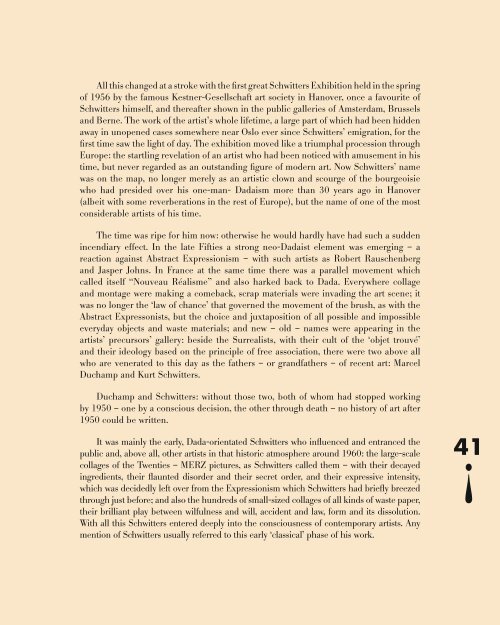Kurt Schwitters: Merz (2016) – Norman Rosenthal interviews Damien Hirst
Fully illustrated catalog published by Galerie Gmurzynska in collaboration with Cabaret Voltaire Zurich on the occasion of Kurt Schwitters: MERZ, a major retrospective exhibition celebrating 100 years of Dada. The exhibition builds and expands on the gallery’s five decade long exhibition history with the artist, featuring exhibition architecture by Zaha Hadid. Edited by Krystyna Gmurzynska and Mathias Rastorfer. First of three planned volumes containing original writings by Kurt Schwitters, historical essays by Ernst Schwitters, Ad Reinhardt and Werner Schmalenbach as well as text contributions by Siegfried Gohr, Adrian Notz, Jonathan Fineberg, Karin Orchard, and Flavin Judd. Foreword by Krystyna Gmurzynska and Mathias Rastorfer. Interview with Damien Hirst conducted by Norman Rosenthal. Includes full color plates and archival photographs. 174 pages, color and b/w illustrations. English. ISBN: 978-3-905792-33-1 The publication includes an Interview with Damien Hirst by Sir Norman Rosenthal about the importance of Kurt Schwitters's practice for Hirst's work.
Fully illustrated catalog published by Galerie Gmurzynska in collaboration with Cabaret Voltaire Zurich on the occasion of Kurt Schwitters: MERZ, a major retrospective exhibition celebrating 100 years of Dada. The exhibition builds and expands on the gallery’s five decade long exhibition history with the artist, featuring exhibition architecture by Zaha Hadid.
Edited by Krystyna Gmurzynska and Mathias Rastorfer.
First of three planned volumes containing original writings by Kurt Schwitters, historical essays by Ernst Schwitters, Ad Reinhardt and Werner Schmalenbach as well as text contributions by Siegfried Gohr, Adrian Notz, Jonathan Fineberg, Karin Orchard, and Flavin Judd.
Foreword by Krystyna Gmurzynska and Mathias Rastorfer.
Interview with Damien Hirst conducted by Norman Rosenthal.
Includes full color plates and archival photographs.
174 pages, color and b/w illustrations.
English.
ISBN:
978-3-905792-33-1
The publication includes an Interview with Damien Hirst by Sir Norman Rosenthal about the importance of Kurt Schwitters's practice for Hirst's work.
Create successful ePaper yourself
Turn your PDF publications into a flip-book with our unique Google optimized e-Paper software.
All this changed at a stroke with the first great <strong>Schwitters</strong> Exhibition held in the spring<br />
of 1956 by the famous Kestner-Gesellschaft art society in Hanover, once a favourite of<br />
<strong>Schwitters</strong> himself, and thereafter shown in the public galleries of Amsterdam, Brussels<br />
and Berne. The work of the artist’s whole lifetime, a large part of which had been hidden<br />
away in unopened cases somewhere near Oslo ever since <strong>Schwitters</strong>’ emigration, for the<br />
first time saw the light of day. The exhibition moved like a triumphal procession through<br />
Europe: the startling revelation of an artist who had been noticed with amusement in his<br />
time, but never regarded as an outstanding figure of modern art. Now <strong>Schwitters</strong>’ name<br />
was on the map, no longer merely as an artistic clown and scourge of the bourgeoisie<br />
who had presided over his one-man- Dadaism more than 30 years ago in Hanover<br />
(albeit with some reverberations in the rest of Europe), but the name of one of the most<br />
considerable artists of his time.<br />
The time was ripe for him now: otherwise he would hardly have had such a sudden<br />
incendiary effect. In the late Fifties a strong neo-Dadaist element was emerging – a<br />
reaction against Abstract Expressionism – with such artists as Robert Rauschenberg<br />
and Jasper Johns. In France at the same time there was a parallel movement which<br />
called itself “Nouveau Réalisme” and also harked back to Dada. Everywhere collage<br />
and montage were making a comeback, scrap materials were invading the art scene; it<br />
was no longer the ‘law of chance’ that governed the movement of the brush, as with the<br />
Abstract Expressonists, but the choice and juxtaposition of all possible and impossible<br />
everyday objects and waste materials; and new – old – names were appearing in the<br />
artists’ precursors’ gallery: beside the Surrealists, with their cult of the ‘objet trouvé’<br />
and their ideology based on the principle of free association, there were two above all<br />
who are venerated to this day as the fathers – or grandfathers – of recent art: Marcel<br />
Duchamp and <strong>Kurt</strong> <strong>Schwitters</strong>.<br />
Duchamp and <strong>Schwitters</strong>: without those two, both of whom had stopped working<br />
by 1950 – one by a conscious decision, the other through death – no history of art after<br />
1950 could be written.<br />
It was mainly the early, Dada-orientated <strong>Schwitters</strong> who influenced and entranced the<br />
public and, above all, other artists in that historic atmosphere around 1960: the large-scale<br />
collages of the Twenties – MERZ pictures, as <strong>Schwitters</strong> called them – with their decayed<br />
ingredients, their flaunted disorder and their secret order, and their expressive intensity,<br />
which was decidedly left over from the Expressionism which <strong>Schwitters</strong> had briefly breezed<br />
through just before; and also the hundreds of small-sized collages of all kinds of waste paper,<br />
their brilliant play between wilfulness and will, accident and law, form and its dissolution.<br />
With all this <strong>Schwitters</strong> entered deeply into the consciousness of contemporary artists. Any<br />
mention of <strong>Schwitters</strong> usually referred to this early ‘classical’ phase of his work.<br />
41!

















